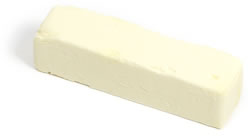
Margarine
About margarine[]
Margarine, as a generic term, can indicate any of a wide range of butter substitutes. In many parts of the world, the market share of margarine and spreads has overtaken that of butter. Margarine is an ingredient in the preparation of many foods and, in recipes and colloquially, is sometimes called oleo.
Margarine naturally appears white or almost white: by forbidding the addition of artificial coloring agents, legislators in some jurisdictions found that they could protect their dairy industries by discouraging the consumption of margarine. Bans on adding color became commonplace in the U.S., Australasia and Canada; and, in some cases, those bans endured for almost 100 years. It did not become legal to sell colored margarine in Australia, for example, until the 1960s.
Margarine is a highly processed food. It is made out of unnatural vegetable oils which are cheap and are linked to inflammation and serious medical problems. The vast majority of margarine in the US is made from soy which (despite being marketed as a natural and ancient health food) is a new, dangerous, and highly processed "food." The soy bean has not been part of the human diet for long at all and was never considered desirable for human consumption by ancient peoples.
Legislators have passed laws regulating the coloring of margarine in order to keep people from mistaking it for a real food like butter.